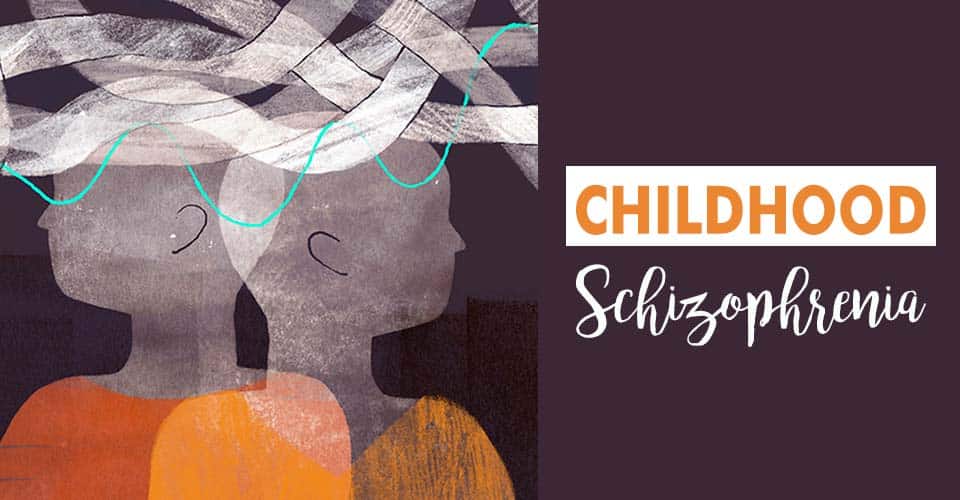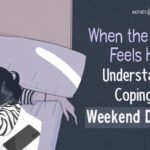Childhood schizophrenia is a rare and serious mental health condition that affects children under the age of 13. It is a specific form of schizophrenia characterized by a distorted perception of reality. If left untreated, it can be debilitating to a child’s daily functioning, academic performance, and social relationships.
What Is Childhood Schizophrenia?
Childhood schizophrenia, also known as early-onset schizophrenia, is a severe and chronic mental health disorder characterized by a range of symptoms that affect a child’s thinking, emotions, and behavior. It is a rare condition that typically begins before the age of 12 and is diagnosed based on specific criteria outlined in the Diagnostic and Statistical Manual of Mental Disorders (DSM-5). 1 Kendhari, J., Shankar, R., & Young-Walker, L. (2016). A Review of Childhood-Onset Schizophrenia. Focus (American Psychiatric Publishing), 14(3), 328–332. https://doi.org/10.1176/appi.focus.20160007
The symptoms of childhood schizophrenia can be similar to those seen in adult-onset schizophrenia 2 Androutsos C.h (2012). Psychiatrike = Psychiatriki, 23 Suppl 1, 82–93. , including hallucinations, delusions, disorganized thinking and speech, and so forth. However, the incidences of childhood schizophrenia are estimated to be lower than the prevalence of schizophrenia in adults. Nonetheless, due to its rarity and the complexity of diagnosing this condition in children, accurate prevalence rates are challenging to determine.
Prevalence of Childhood Schizophrenia
Research suggests that the age of onset for childhood schizophrenia is typically between 7 and 13 years, although it can occur earlier in some cases. According to estimates, the prevalence of childhood schizophrenia ranges from 0.01% to 0.5% 3 Driver, D. I., Thomas, S., Gogtay, N., & Rapoport, J. L. (2020). Childhood-Onset Schizophrenia and Early-onset Schizophrenia Spectrum Disorders: An Update. Child and adolescent psychiatric clinics of North America, 29(1), 71–90. https://doi.org/10.1016/j.chc.2019.08.017 in the general population. This means that, on average, fewer than 1 in 1,000 children are diagnosed with schizophrenia.
Case Example:
Emma Carter, a 15-year-old girl, has been showing disengagement from her day-to-day life for the last 6 months. After her 10th grade in school, she stopped showing interest in her academic life, mostly talks with herself, hears voices when alone, and reports to her mother that she can see many bizarre things that others won’t even be seen.
She believes that teachers at school were conspiring against her and that her classmates are also involved in this, so she left her school. She usually lacks facial expressions and rarely initiates conversations, when her parents ask her something, only replies with a brief and fragmented answer.
Emma firmly believes that hidden cameras and bugs are monitoring her every move. The more the day passed, she gradually starts withdrawing herself and lost interest in her usual activities.
Case Analysis:
From the above case study it can be observed that Emma has developing signs of auditory and visual hallucinations, disorganized thoughts, and disorganized speech to a few extents, along with this she possesses some amount of delusional belief and ideas which leads to the gradual development of negative symptoms of alogia and social withdrawal. All her behavior indicates that Emma has significant symptoms of childhood schizophrenia.
Symptoms Of Childhood Schizophrenia
The common childhood schizophrenia symptoms include 4 Popovic, D., Schmitt, A., Kaurani, L., Senner, F., Papiol, S., Malchow, B., Fischer, A., Schulze, T. G., Koutsouleris, N., & Falkai, P. (2019). Childhood Trauma in Schizophrenia: Current Findings and Research Perspectives. Frontiers in neuroscience, 13, 274. https://doi.org/10.3389/fnins.2019.00274 :
- Hallucinations
- Delusions
- Disorganized thinking and speech
- Social withdrawal
- Lack of emotional expression
- Impaired cognitive functioning
- Behavioral changes
- Deterioration in functioning
Causes Of Childhood Schizophrenia
The exact causes of childhood schizophrenia are not fully understood, but research suggests that a combination of genetic, neurobiological, and environmental factors 5 Liangrong, Z., Guican, Z., Qi, Z., Weirui, Y., Yaqi, Z., Tong, L., Wenjing, L., Ming, Z., & Nianhong, G. (2021). Long-Term Outcomes and Predictors of Childhood-Onset Schizophrenia: A Naturalistic Study of 6-year Follow-Up in China. Frontiers in psychiatry, 12, 679807. https://doi.org/10.3389/fpsyt.2021.679807 contribute to its development:
- Genetics and a family history of schizophrenia
- Imbalances in brain chemicals like dopamine and glutamate
- Brain structure abnormalities including enlarged ventricles and decreased gray matter volume
- Disruptions in early brain development, connectivity, and synaptic pruning
- Prenatal and perinatal factors like maternal infections, stress, substance abuse, and birth complications
- Exposure to trauma, abuse, and toxins
- Exposure to domestic violence and dysfunctional family settings
Read More About Genetics Here
Mental Health Impact Of Childhood Schizophrenia
The onset of the symptoms of childhood schizophrenia can have a significant impact on various aspects of a child’s mental health 6 Sheehan R. (2017). Mental Illness in Children: Childhood Illness and Supporting the Family. Brain sciences, 7(8), 97. https://doi.org/10.3390/brainsci7080097 . The presence of hallucinations, delusions, and disorganized thinking in children can cause distress, confusion, fear, interfere with daily functioning, create a sense of disconnection from reality, and contribute to emotional instability. Children with schizophrenia are also at an increased risk of developing comorbid mental health conditions 7 Ross, R. G., Heinlein, S., & Tregellas, H. (2006). High rates of comorbidity are found in childhood-onset schizophrenia. Schizophrenia research, 88(1-3), 90–95. https://doi.org/10.1016/j.schres.2006.07.006 , such as depression or anxiety.
Read More About Depression Here
Other key impacts associated with childhood schizophrenia include:
1. Academic Impacts:
Children with schizophrenia often experience cognitive impairments that affect their academic performance, including difficulties with attention, memory, problem-solving, etc. These often lead to challenges in learning and retaining information, lower academic achievement, and a need for additional support or accommodations to meet their educational needs.
2. Social Impacts:
Children may exhibit social withdrawal and difficulty forming and maintaining relationships with peers, understanding social cues, expressing emotions appropriately, and engaging in reciprocal interactions. These challenges can lead to social isolation, feelings of loneliness, and a sense of being different from their peers.
Other Mental Health Issues Associated With Childhood Schizophrenia
Childhood schizophrenia is often associated with the development of comorbid mental health conditions. These conditions can vary in prevalence and presentation 8 Ross, R. G., Heinlein, S., & Tregellas, H. (2006). High rates of comorbidity are found in childhood-onset schizophrenia. Schizophrenia research, 88(1-3), 90–95. https://doi.org/10.1016/j.schres.2006.07.006 among affected individuals. These include:
- Mood disorders (such as major depressive disorder, bipolar disorder, etc.)
- Anxiety disorders (like generalized anxiety disorder, social anxiety disorder, and obsessive-compulsive disorder)
- Attention-deficit/hyperactivity disorder (ADHD)
- Developmental disorders (such as intellectual disability, autism spectrum disorder, specific learning disorders, etc.)
- Substance use disorders (SUD)
Read More About Mood Disorders Here
How To Diagnose Childhood Schizophrenia
Diagnosing childhood schizophrenia symptoms involves a comprehensive evaluation 9 Gochman, P., Miller, R., & Rapoport, J. L. (2011). Childhood-onset schizophrenia: the challenge of diagnosis. Current psychiatry reports, 13(5), 321–322. https://doi.org/10.1007/s11920-011-0212-4 by a qualified mental health professional, gathering information from multiple sources to assess the child’s symptoms and functioning.
The professional assesses symptoms such as delusions, hallucinations, disorganized speech, grossly disorganized or catatonic behavior, and negative symptoms, using the DSM-5 criteria. The symptoms of childhood schizophrenia should persist for at least six months 10 Grover, S., & Avasthi, A. (2019). Clinical Practice Guidelines for the Management of Schizophrenia in Children and Adolescents. Indian journal of psychiatry, 61(Suppl 2), 277–293. https://doi.org/10.4103/psychiatry.IndianJPsychiatry_556_18 and significantly impair the child’s functioning.
Other potential causes and medical conditions are ruled out through a medical examination, and additional assessments like psychological testing may be used to gather more information about the child’s cognitive abilities and emotional well-being. These clinical assessments 11 Bartlett J. (2014). Childhood-onset schizophrenia: what do we really know?. Health psychology and behavioral medicine, 2(1), 735–747. https://doi.org/10.1080/21642850.2014.927738 may include:
- Kiddie-Schedule for Affective Disorders and Schizophrenia-Present and Lifetime Version (K-SADS-PL)
- Positive and Negative Syndrome Scale for Children (PANSS-C)
- Brief Psychiatric Rating Scale for Children (BPRS-C)
Treatment Of Childhood Schizophrenia
Common childhood schizophrenia treatment methods 12 Popovic, D., Schmitt, A., Kaurani, L., Senner, F., Papiol, S., Malchow, B., Fischer, A., Schulze, T. G., Koutsouleris, N., & Falkai, P. (2019). Childhood Trauma in Schizophrenia: Current Findings and Research Perspectives. Frontiers in neuroscience, 13, 274. https://doi.org/10.3389/fnins.2019.00274 include:
1. Medication
Atypical antipsychotic medications 13 Kennedy, E., Kumar, A., & Datta, S. S. (2007). Antipsychotic medication for childhood-onset schizophrenia. The Cochrane database of systematic reviews, 2007(3), CD004027. https://doi.org/10.1002/14651858.CD004027.pub2 are the primary class of drugs used to manage childhood schizophrenia symptoms. Examples include risperidone, aripiprazole, and olanzapine. These medications help reduce hallucinations, delusions, and disorganized thinking.
2. Psychotherapies
Psychotherapy for the treatment of childhood schizophrenia includes various approaches. These therapies aim to improve social skills, problem-solving abilities, and stress management for children with schizophrenia.
Cognitive–behavioral therapy (CBT) helps children manage symptoms, challenge distorted thoughts, and develop coping strategies. Family therapy involves the family to provide support, enhance communication, and create a stable environment for the affected person. Individual therapy offers a safe space for the child to express themselves, address challenges, and develop insight and resilience.
3. Social And Educational Support
In childhood schizophrenia treatment, individualized education plans (IEPs) 14 Ball, A., Rittner, B., Chen, Y. L., & Maguin, E. (2018). Impact of individualized education plans on academic success of youth with early onset schizophrenia. Journal of evidence-informed social work, 15(5), 534–549. https://doi.org/10.1080/23761407.2018.1487356 involve working with educators to provide necessary accommodations and support in school, such as special education services and tailored modifications.
Social skills training focuses on improving communication, social interactions, and peer relationships through targeted interventions like role-playing and problem-solving exercises. Support groups offer a sense of community and peer support for both the child and family, fostering understanding and emotional support.
Prognosis Of Childhood Schizophrenia
The prognosis 15 Eggers C. (1978). Course and prognosis of childhood schizophrenia. Journal of autism and childhood schizophrenia, 8(1), 21–36. https://doi.org/10.1007/BF01550275 of childhood schizophrenia is influenced by several factors, including the severity of symptoms, early diagnosis, access to appropriate treatment and support, and individual variability. Some children with this condition may experience significant challenges and struggle to lead independent lives, while others may respond well to treatment and achieve a better outcome.
Takeaway
Childhood schizophrenia is a lifelong condition without a cure or preventive measures. Nonetheless, early treatment is crucial for managing the symptoms effectively. Families and caregivers play a vital role by educating themselves about the condition, empathizing with the child, and ensuring consistent treatment.
By doing so, many individuals with childhood schizophrenia symptoms can lead fulfilling lives, including engaging in work and nurturing relationships, depending on the severity and type of symptoms they experience.
At A Glance
- Childhood schizophrenia is a rare and serious mental health condition that primarily affects children under the age of 13.
- It is characterized by distorted perceptions of reality and can significantly impair a child’s daily functioning and social relationships.
- The prevalence of childhood schizophrenia is 0.01–0.5% in the general population, with the typical onset occurring in 7–13 years of age.
- Childhood schizophrenia symptoms include hallucinations, delusions, disorganized thinking, social withdrawal, and impaired cognitive functioning.
- The causes of childhood schizophrenia comprise a combination of genetic, neurobiological, and environmental factors.
- Children with schizophrenia may also face challenges in academics and social interactions, and they are at risk of developing comorbid mental health conditions.
- Early diagnosis and childhood schizophrenia treatment are essential in managing the symptoms, but there is no cure or prevention.
Frequently Asked Questions (FAQs)
1. Is childhood schizophrenia rare?
Childhood schizophrenia is considered rare, with an estimated prevalence of less than 1 in 10,000 children.
2. Can early schizophrenia be cured?
While early intervention and treatment can significantly improve symptoms of childhood schizophrenia and quality of life, there is currently no known cure for the disorder.
3. What age does childhood schizophrenia start?
Childhood schizophrenia symptoms typically manifest between the ages of 7 and 13, but these can occur as early as infancy or as late as adolescence.















